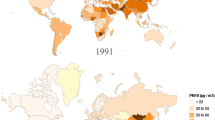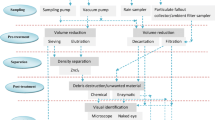Abstract
In the framework of two national research projects (ORGANOSOL and CN-linkAIR), fine particulate matter (PM2.5) was sampled for 17 months at an urban location in the Western European Coast. The PM2.5 samples were analyzed for organic carbon (OC), water-soluble organic carbon (WSOC), elemental carbon (EC), major water-soluble inorganic ions, mineralogical, and for the first time in this region, strontium isotope (87Sr/86Sr) composition. Organic matter dominates the identifiable urban PM2.5 mass, followed by secondary inorganic aerosols. The acquired data resulted also in a seasonal overview of the carbonaceous and inorganic aerosol composition, with an important contribution from primary biomass burning and secondary formation processes in colder and warmer periods, respectively. The fossil-related primary EC seems to be continually present throughout the sampling period. The 87Sr/86Sr ratios were measured on both the labile and residual PM2.5 fractions as well as on the bulk PM2.5 samples. Regardless of the air mass origin, the residual fractions are more radiogenic (representative of a natural crustal dust source) than the labile fractions, whose 87Sr/86Sr ratios are comparable to that of seawater. The 87Sr/86Sr ratios and the mineralogical composition data further suggest that sea salt and mineral dust are important primary natural sources of fine aerosols throughout the sampling period.





Similar content being viewed by others
References
Aarons SM, Aciego SM, Gleason JD (2013) Variable Hf-Sr-Nd radiogenic isotopic compositions in a Saharan dust storm over the Atlantic: implications for dust flux to oceans, ice sheets and the terrestrial biosphere. Chem Geol 349-350:18–26. doi:10.1016/j.chemgeo.2013.04.010
Arnold HE, Kerrison P, Steinke M (2013) Interacting effects of ocean acidification and warming on growth and DMS-production in the haptophyte coccolithophore Emiliania huxleyi. Glob Change Biol 19:1007–1016. doi:10.1111/gcb.12105
Atkinson RW, Mills IC, Walton HA, Anderson HR (2015) Fine particle components and health—a systematic review and meta-analysis of epidemiological time series studies of daily mortality and hospital admissions. J Expo Sci Environ Epidemiol 25:208–214. doi:10.1038/jes.2014.63
Behera SN, Sharma M, Aneja VP, Balasubramanian R (2013) Ammonia in the atmosphere: a review on emission sources, atmospheric chemistry and deposition on terrestrial bodies. Environ Sci Pollut Res 20:8092–8131. doi:10.1007/s11356-013-2051-9
Booth BBB, Dunstone NJ, Halloran PR et al (2012) Aerosols implicated as a prime driver of twentieth-century North Atlantic climate variability. Nature 484:228–232. doi:10.1038/nature10946
Callén MS, Iturmendi A, López JM (2014) Source apportionment of atmospheric PM2.5-bound polycyclic aromatic hydrocarbons by a PMF receptor model. Assessment of potential risk for human health. Environ Pollut 195:167–177. doi:10.1016/j.envpol.2014.08.025
Cassee FR, Héroux M-E, Gerlofs-Nijland ME, Kelly FJ (2013) Particulate matter beyond mass: recent health evidence on the role of fractions, chemical constituents and sources of emission. Inhal Toxicol 25(14):802–812. doi:10.3109/08958378.2013.850127
Dinar E, Taraniuk I, Graber ER (2006) Cloud condensation nuclei properties of model and atmospheric HULIS. Atmos Chem Phys 6:2465–2482. doi:10.5194/acp-6-2465-2006
Duarte RMBO, Santos EBH, Pio CA, Duarte AC (2007) Comparison of structural features of water-soluble organic matter from atmospheric aerosols with those of aquatic humic substances. Atmos Environ 41:8100–8113. doi:10.1016/j.atmosenv.2007.06.034
Duarte RMBO, Freire SMSC, Duarte AC (2015) Investigating the water-soluble organic functionality of urban aerosols using two-dimensional correlation of solid-state 13C NMR and FTIR spectral data. Atmos Environ 116:245–252. doi:10.1016/j.atmosenv.2015.06.043
Faure G, Mensing TM (2005) Isotopes: principles and applications. Wiley, Hoboken
Gelencsér A, May B, Simpson D, Sánchez-Ochoa A, Kasper-Giebl A, Puxbaum H, Caseiro A, Pio C, Legrand M (2007) Source apportionment of PM2.5 organic aerosol over Europe: primary/secondary, natural/anthropogenic, fossil/biogenic origin. J Geophys Res 112:D23S04. doi:10.1029/2006JD008094
Grousset FE, Biscaye PE (2005) Tracing dust sources and transport patterns using Sr, Nd and Pb isotopes. Chem Geol 222:149–167. doi:10.1016/j.chemgeo.2005.05.006
Heal MR, Kumar P, Harrison RM (2012) Particles, air quality, policy and health. Chem Soc Rev 41:6606–6630. doi:10.1039/c2cs35076a
Jochum KP, Nohl U, Herwig K, Lammel E, Stoll B, Hofmann AW (2005) GeoReM: a new geochemical database for reference materials and isotopic standards. Geostand Geoanal Res 29(3):333–338. doi:10.1111/j.1751-908X.2005.tb00904.x
Jones AM, Harrison RM (2005) Interpretation of particulate elemental and organic carbon concentrations at rural, urban and kerbside sites. Atmos Environ 39:7114–7126. doi:10.1016/j.atmosenv.2005.08.017
Kanakidou M, Seinfeld JH, Pandis SN et al (2005) Organic aerosol and global climate modelling: a review. Atmos Chem Phys 5:1053–1123. doi:10.5194/acp-5-1053-2005
Kanayama S, Yabuki S, Yanagisawa F, Motoyam R (2002) The chemical and strontium isotope composition of atmospheric aerosols over Japan: the contribution of long-range-transported Asian dust (Kosa). Atmos Environ 36:5159–5175. doi:10.1016/S1352-2310(02)00587-3
Kiss G, Varga B, Galambos I, Ganszky I (2002) Characterization of water-soluble organic matter isolated from atmospheric fine aerosol. J Geophys Res 107(D21):8339. doi:10.1029/2001JD000603
Kumar A, Abouchami W, Galer SJG et al (2014) A radiogenic isotope tracer study of transatlantic dust transport from Africa to the Caribbean. Atmos Environ 82:130–143. doi:10.1016/j.atmosenv.2013.10.021
Laskin A, Iedema MJ, Cowin JP (2002) Quantitative time-resolved monitoring of nitrate formation in sea salt particles using a CCSEM/EDX single particle analysis. Environ. Sci. Technol. 36:4948–4955. doi:10.1021/es020551k
Li W, Chi J, Shi Z et al (2014) Composition and hygroscopicity of aerosol particles at Mt. Lu in South China: implications for acid precipitation. Atmos Environ 94:626–636. doi:10.1016/j.atmosenv.2014.06.003
Lohmann U, Feichter J (2005) Global indirect aerosol effects: a review. Atmos Chem Phys 5:715–737. doi:10.5194/acp-5-715-2005
Lopes SP, Matos JTV, Silva AMS, Duarte AC, Duarte RMBO (2015) 1H NMR studies of water- and alkaline-soluble organic matter from fine urban atmospheric aerosols. Atmos Environ 119:374–380. doi:10.1016/j.atmosenv.2015.08.072
Mahowald N, Ward DS, Kloster S et al (2011) Aerosol impacts on climate and biogeochemistry. Annu Rev Environ Resour 36:45–74. doi:10.1146/annurev-environ-042009-094507
Mantas E, Remoundaki E, Halari I et al (2014) Mass closure and source apportionment of PM2.5 by positive matrix factorization analysis in urban Mediterranean environment. Atmos Environ 94:154–163. doi:10.1016/j.atmosenv.2014.05.002
Matos JTV, Duarte RMBO, Duarte AC (2015) Natural organic matter in urban aerosols: comparison between water and alkaline soluble components using excitation-emission matrix fluorescence spectroscopy and multiway data analysis. Atmos Environ 102:1–10. doi:10.1016/j.atmosenv.2014.11.042
Ocskay R, Salma I, Wang W et al (2006) Characterization and diurnal variation of size-resolved inorganic water-soluble ions at a rural background site. J Environ Monit 8:300–306. doi:10.1039/b513915e
Park RJ, Jacob DJ, Chin M, Martin RV (2003) Sources of carbonaceous aerosols over the United States and implications for natural visibility. J Geophys Res 108:4355. doi:10.1029/2002JD003190
Pio CA, Legrand M, Oliveira T (2007) Climatology of aerosol composition (organic versus inorganic) at nonurban sites on a west-east transect across Europe. J Geophys Res 112:D23S02. doi:10.1029/2006JD008038
Pio C, Cerqueira M, Harrison RM, Nunes T, Mirante F, Alves C, Oliveira C, Sanchez de la Campa A, Artíñano B, Matos M (2011) OC/EC ratio observations in Europe: Re-thinking the approach for apportionment between primary and secondary organic carbon. Atmos Environ 45:6121–6132. doi:10.1016/j.atmosenv.2011.08.045
Pöschl U (2005) Atmospheric aerosols: composition, transformation, climate and health effects. Angew Chem Int Ed 44:7520–7540. doi:10.1002/anie.200501122
Putaud J-P, Raesa F, van Dingenen R et al (2004) A European aerosol phenomenology—2: chemical characteristics of particulate matter at kerbside, urban, rural and background sites in Europe. Atmos Environ 38:2579–2595. doi:10.1016/j.atmosenv.2004.01.041
Putaud J-P, van Dingenen R, Alastuey A et al (2010) A European aerosol phenomenology—3: physical and chemical characteristics of particulate matter from 60 rural, urban, and kerbside sites across Europe. Atmos Environ 44:1308–1320. doi:10.1016/j.atmosenv.2009.12.011
Querol X, Alastuey A, Ruiz CR et al (2004) Speciation and origin of PM10 and PM2.5 in selected European cities. Atmos Environ 38:6547–6555. doi:10.1016/j.atmosenv.2004.08.037
Reid JP, Sayer RM (2003) Heterogeneous atmospheric aerosol chemistry: laboratory studies of chemistry on water droplets. Chem Soc Rev 32:70–79. doi:10.1039/b204463n
Reis S, Pinder RW, Zhang M, Lijie G, Sutton MA (2009) Reactive nitrogen in atmospheric emission inventories. Atmos Chem Phys 9:7657–7677. doi:10.5194/acp-9-7657-2009
Ribeiro S, Azevedo MR, Santos JF, Medina J, Costa A (2014) Sr isotopic signatures of Portuguese bottled mineral waters and their relationships with the geological setting. Comunicações Geológicas 100(1):89–98
Saffari A, Daher N, Shafer MM, Schauer JJ, Sioutas C (2014) Global perspective on the oxidative potential of airborne particulate matter: a synthesis of research findings. Environ Sci Technol 48:7576–7583. doi:10.1021/es500937x
Shakya KM, Place PF Jr, Griffin RJ, Talbot RW (2012) Carbonaceous content and water-soluble organic functionality of atmospheric aerosols at a semi-rural New England location. J Geophys Res 117:D03301. doi:10.1029/2011JD016113
Sherman LS, Blum JD, Dvonch JT, Gratz LE, Landis MS (2015) The use of Pb, Sr, and Hg isotopes in Great Lakes precipitation as a tool for pollution source attribution. Sci Total Environ 502:362–374. doi:10.1016/j.scitotenv.2014.09.034
Solorzano L (1969) Determination of ammonia in natural waters by the phenol hypochlorite method. Limnol Oceanogr 14:799–801. doi:10.4319/lo.1969.14.5.0799
Terzi E, Argyropoulos G, Bougatioti A et al (2010) Chemical composition and mass closure of ambient PM10 at urban sites. Atmos Environ 44:2231–2239. doi:10.1016/j.atmosenv.2010.02.019
Tositti L, Brattich E, Masiol M et al (2014) Source apportionment of particulate matter in a large city of southeastern Po Valley (Bologna, Italy). Environ Sci Pollut Res 21:872–890. doi:10.1007/s11356-013-1911-7
van Dingenen R, Raesa F, Putaud J-P et al (2004) A European aerosol phenomenology—1: physical characteristics of particulate matter at kerbside, urban, rural and background sites in Europe. Atmos Environ 38:2561–2577. doi:10.1016/j.atmosenv.2004.01.040
Wozniak AS, Bauer JE, Dickhut RM (2012) Characteristics of water-soluble organic carbon associated with aerosol particles in the eastern United States. Atmos Environ 46:181–188. doi:10.1016/j.atmosenv.2011.10.001
Yang M, Huebert BJ, Blomquist BW et al (2011) Atmospheric sulfur cycling in the southeastern Pacific—longitudinal distribution, vertical profile, and diel variability observed during VOCALS-Rex. Atmos Chem Phys 11:5079–5097. doi:10.5194/acp-11-5079-2011
Acknowledgments
This work was supported by Centre for Environmental and Marine Studies (CESAM) (UID/AMB/50017/2013; University of Aveiro), CICECO—Aveiro Institute of Materials, (UID/CTM/50011/2013; University of Aveiro), and the Portuguese Science and Technology Foundation (FCT), through the European Social Fund (ESF) and “Programa Operacional Potencial Humano e POPH.” FCT is also acknowledged for a post-doctoral (Regina M.B.O. Duarte, SFRH/BPD/102882/2014) and a Ph.D. grant (João T.V. Matos, SFRH/BD/84247/2012). This work was funded by FEDER under the Operational Program for Competitiveness Factors e COMPETE and by National funds via FCT within the framework of research projects ORGANOSOL (PTDC/CTE-ATM/118551/2010) and CN-linkAIR (PTDC/AAG-MAA/2584/2012).
Author information
Authors and Affiliations
Corresponding author
Additional information
Responsible editor: Philippe Garrigues
Electronic supplementary material
ESM 1
(DOCX 1854 kb)
Rights and permissions
About this article
Cite this article
Duarte, R.M.B.O., Matos, J.T.V., Paula, A.S. et al. Tracing of aerosol sources in an urban environment using chemical, Sr isotope, and mineralogical characterization. Environ Sci Pollut Res 24, 11006–11016 (2017). https://doi.org/10.1007/s11356-016-7793-8
Received:
Accepted:
Published:
Issue Date:
DOI: https://doi.org/10.1007/s11356-016-7793-8




